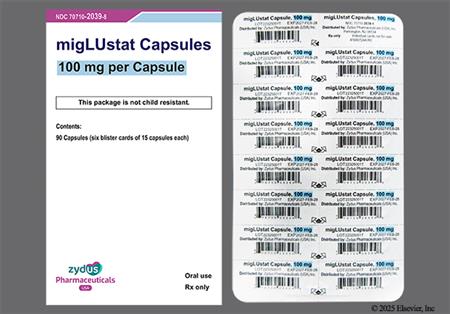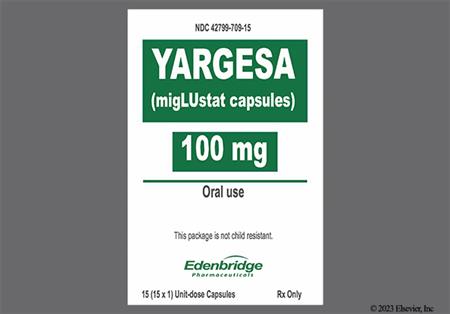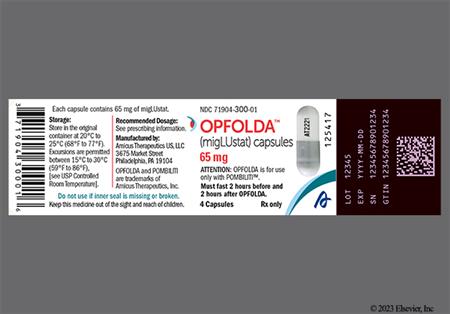ThisiscontentfromElsevier'sDrugInformation
Miglustat
Learn more about Elsevier's Drug Information today! Get the drug data and decision support you need, including TRUE Daily Updates™ including every day including weekends and holidays.
NOTE: Miglustat is designated as an orphan drug by the FDA for this indication.
100 mg PO 3 times per day at regular intervals. The dosage may be reduced to 100 mg PO once or twice daily if adverse reactions (e.g., diarrhea or tremor) are not tolerated.[49418]
NOTE: Miglustat is designated as an orphan drug by the FDA for this indication.
260 mg PO every other week 1 hour prior to intravenous cipaglucosidase alfa. Begin therapy 2 weeks after the last enzyme replacement therapy (ERT) dose.[69535]
195 mg PO every other week 1 hour prior to intravenous cipaglucosidase alfa. Begin therapy 2 weeks after the last enzyme replacement therapy (ERT) dose.[69535]
weighing 50 kg or more: 300 mg/day PO for type 1 Gaucher disease; 260 mg PO every other week for acid alpha-glucosidase deficiency (Pompe disease).
weighing 40 to 49 kg: 300 mg/day PO for type 1 Gaucher disease; 195 mg PO every other week for acid alpha-glucosidase deficiency (Pompe disease).
weighing 50 kg or more: 300 mg/day PO for type 1 Gaucher disease; 260 mg PO every other week for acid alpha-glucosidase deficiency (Pompe disease).
weighing 40 to 49 kg: 300 mg/day PO for type 1 Gaucher disease; 195 mg PO every other week for acid alpha-glucosidase deficiency (Pompe disease).
Safety and efficacy have not been established.
Safety and efficacy have not been established.
Safety and efficacy have not been established.
Safety and efficacy have not been established.
Specific guidelines for dosage adjustments in hepatic impairment are not available; it appears that no dosage adjustments are needed.
miglustat (Zavesca):
CrCl more than 70 mL/minute: No dosage adjustment needed.
CrCl 50 to 70 mL/minute: 100 mg PO twice daily.
CrCl 30 to 49 mL/minute: 100 mg PO once daily.
CrCl less than 30 mL/minute: Not recommended.[49418]
miglustat (Opfolda):
Adults weighing 50 kg or more
CrCl 60 to 89 mL/minute: No dosage adjustment needed.
CrCl 15 to 59 mL/minute: 195 mg PO every other week 1 hour prior to intravenous cipaglucosidase alfa.
Adults weighing 40 to 49 kg
CrCl 60 to 89 mL/minute: No dosage adjustment needed.
CrCl 15 to 59 mL/minute: 130 mg PO every other week 1 hour prior to intravenous cipaglucosidase alfa.[69535]
† Off-label indication


Miglustat is an oral therapy used for the treatment of adults with type 1 Gaucher disease. It is also indicated, in combination with cipaglucosidase alfa, for the treatment of adult patients with late-onset acid alpha-glucosidase deficiency (Pompe disease) who are not improving on their current therapy. Miglustat is a competitive and reversible inhibitor of the enzyme glucosylceramide synthase, the initial enzyme responsible in the synthesis of glucosylceramide. In type 1 Gaucher disease, a genetic disease found most commonly among Ashkenazi Jews, patients are deficient in the enzyme glucocerebrosidase, which is responsible for degradation of glucosylceramide. Glucosylceramide arises mainly from the breakdown of red and white blood cells and turnover of lipids during CNS myelin sheath formation. As evident in type 1 Gaucher disease, excess storage of glucosylceramide occurs within the macrophage lysosome, leading to progressive organ enlargement (liver, spleen, bone marrow), thrombocytopenia, anemia, recurrent infection, and skeletal weakening (e.g., osteonecrosis, osteopenia).[27584] Rather than replacing glucocerebrosidase, which may be done in some patients with Gaucher disease via the use of drugs like imiglucerase, miglustat acts as a substrate reducer (by inhibiting glucosylceramide synthase) and allows the available glucocerebrosidase enzyme to be more effective.[27585] Adverse reactions such as diarrhea, weight loss, and tremor are common with miglustat therapy for type 1 Gaucher disease and may necessitate a dosage reduction in some patients.[49418] Pompe disease is caused by a genetic deficiency in acid alpha-glucosidase, an enzyme required for lysosomal glycogen degradation. Accumulation of glycogen in skeletal and heart muscle results in muscular weakness and respiratory or heart failure. In late-onset Pompe disease, miglustat is given in combination with cipaglucosidase alfa, an exogenous source of acid alpha-glucosidase. Miglustat stabilizes and reduces the inactivation of cipaglucosidase alfa in the blood.[69535][69537][69539]
For storage information, see the specific product information within the How Supplied section.
Miglustat (Zavesca)
Miglustat (Opfolda)
Diarrhea and weight loss are common with miglustat therapy in patients with Gaucher disease, and appear to be most evident in the first 12 months of therapy. Diarrhea may present at the outset or intermittently during treatment. In clinical trials, 89% to 100% of patients reported diarrhea, while weight loss was noted in 39% to 67% of patients. The diarrhea appears to be due to the disaccharidase inhibitory activity of miglustat, resulting in an osmotic diarrhea. Weight loss may be due to diarrhea, decreased food intake, a combination of both, or other factors. The incidence of diarrhea appears to decrease over time; however, lowering the dose to 50 mg PO 3 times per day did not reduce the incidence of diarrhea. Loperamide has been used frequently to help control diarrhea. Patients may be instructed to avoid high carbohydrate foods during treatment with miglustat if they present with diarrhea. Evaluate individuals with persistent gastrointestinal events who do not respond to usual interventions for underlying gastrointestinal disease. Continue miglustat therapy in individuals with significant gastrointestinal disease only after consideration of the risks and benefits of continued treatment. Other gastrointestinal complaints that have been reported in 5% or more of patients receiving miglustat at a dose of 50 to 100 mg 3 times a day include: abdominal pain (18% to 67%), anorexia (0% to 7%), bloating or abdominal distention (0% to 8%), constipation (8%), dyspepsia (0% to 7%), flatulence (29% to 50%), nausea (8% to 22%), vomiting (4% to 11%), epigastric pain (0% to 6%), and xerostomia (8%).[49418] Diarrhea (5.9%), abdominal distention (3.5%), abdominal pain (2.4%), nausea (2.4%), constipation (at least 2%), and dyspepsia (at least 2%) occurred in patients receiving miglustat in combination with cipaglucosidase alfa during clinical trials for the treatment of acid alpha-glucosidase deficiency (Pompe disease).[69535]
Tremor or exacerbation of tremor (primarily in the hands) has been reported in 11% to 30% of patients receiving miglustat for the treatment of Gaucher disease. Tremors may begin within the first month of therapy, but often resolve by the third month of therapy. Dose reduction may help to lessen tremors within days; however, in the clinical trials tremor occurred in 11% of patients receiving either 50 or 100 mg of miglustat PO 3 times per day. Complete discontinuation of miglustat therapy may be required in some cases. Peripheral neuropathy has also been reported in 3% of patients receiving miglustat for the treatment of Gaucher disease; neurological evaluation is recommended every 6 months. If tingling or numbness of the extremities develop, re-evaluate the risk and benefits of therapy and consider drug discontinuation. Other central and peripheral nervous system complaints that have been reported in 5% or more of patients receiving miglustat at a dose of 50 to 100 mg PO 3 times per day include: dizziness (0% to 11%), headache (21% to 22%), leg or muscle cramps (0% to 11%), memory loss (8%), migraine (0% to 6%), paresthesias (0% to 7%), and unsteady gait (8%).[49418] Dizziness (4.7%), headache/migraine (8.2%), muscle spasm (2.4%), paresthesias (at least 2%), and tremor (at least 2%) were reported in patients receiving miglustat with cipaglucosidase alfa in clinical trials for the treatment of acid alpha-glucosidase deficiency (Pompe disease). Somnolence was reported in at least 2% of patients treated with miglustat in combination with cipaglucosidase alfa-atga across 3 clinical trials.[69535]
Menstrual irregularity was reported in 0% to 6% of people receiving miglustat for the treatment of Gaucher disease. No effects on fertility were found during a small study of healthy males (n = 7) taking miglustat for 6 weeks. However, during animal studies, miglustat caused infertility in male rats; this effect was reversible. In female rats, miglustat increased post-implantation loss and decreased embryo-fetal survival.[49418] [69535]
Visual impairment, including visual disturbance, has been reported by 0% to 17% of patients receiving miglustat for the treatment of Gaucher disease.[49418]
Thrombocytopenia was reported in 6% to 7% of patients receiving miglustat for the treatment of Gaucher disease. A decrease in platelet count was also reported in patients receiving miglustat with cipaglucosidase alfa (at least 2%) for treatment of acid alpha-glucosidase deficiency (Pompe disease).[49418] [69535]
Generalized weakness (17%), back pain (8%), and a feeling of heaviness in the limbs (8%) were reported during clinical trials with miglustat for the treatment of Gaucher disease.[49418]
Dyspnea (3.5%), fever (3.5%), chills (2.4%), flushing (2.4%), pruritus (2.4%), and urticaria (2.4%) were reported in patients receiving miglustat with cipaglucosidase alfa during clinical trials. Rash, including erythematous rash and macular rash, was reported in 3.5% of patients receiving miglustat with cipaglucosidase alfa.[69535]
Dysgeusia and sinus tachycardia were reported in 2.4% of patient receiving miglustat with cipaglucosidase alfa during clinical trials for the treatment of acid alpha-glucosidase deficiency (Pompe disease). Other adverse reactions that were reported in at least 2% of patients treated with miglustat with cipaglucosidase alfa include: myalgia, arthralgia, hypertension, pain, asthenia, flank pain, and malaise.[69535]
The coadministration of certain medications may lead to harm and require avoidance or therapy modification; review all drug interactions prior to concomitant use of other medications.
This medication is contraindicated in patients with a history of hypersensitivity to it or any of its components.
The clearance of miglustat may be dramatically decreased in patients with renal impairment. Use of miglustat for type 1 Gaucher disease is not recommended in patients with severe renal impairment, renal failure, or renal disease leading to these conditions; adjust dose based on creatine clearance (CrCl) in patients with mild to moderate renal impairment. Miglustat clearance is estimated to be decreased by as much as 70% in patients with severe renal impairment or renal failure; in patients with mild to moderate renal impairment, clearance may be decreased by 40% to 60%. Adjust the dose of miglustat based on CrCl in patients with acid alpha-glucosidase deficiency (Pompe disease) and moderate to severe renal impairment; use is not recommended in patients with end stage renal disease.[49418] [69535]
Miglustat in combination with cipaglucosidase alfa for the treatment of Pompe disease is contraindicated during pregnancy.[69535] Use miglustat monotherapy with caution in Gaucher disease.[49418] There are no available human data on the use of miglustat during pregnancy to evaluate a drug-associated risk of major birth defects, miscarriage, or other adverse outcomes. However, fetal harm has been observed in animal studies. Great vessel and cardiac malformations were increased in offspring of pregnant rabbits treated with cipaglucosidase alfa and miglustat at 3-fold and 16-fold, respectively, the maximum recommended human dose (MRHD).[69535] When given as monotherapy in animal reproduction studies, miglustat was maternally toxic in rabbits at exposures near the expected therapeutic dose and caused embyro-fetal toxicities (decreased fetal survival, decreased fetal and pup weights) in rats at doses twice the recommended human dose. Delayed and prolonged parturition were also observed.[49418] Imiglucerase has been suggested as an alternative agent for the treatment of Gaucher disease in pregnant patients, based on available data.[56701] [56702]
Counsel people who may become pregnant and people who can cause pregnancy in others about the reproductive risk associated with miglustat. In patients with Pompe disease, verify pregnancy status prior to treatment initiation of miglustat with cipaglucosidase alfa. Advise people who may become pregnant to use effective contraception while taking miglustat with cipaglucosidase alfa and for 60 days after the last dose.[69535] No effects on fertility were found during a small study of healthy males (n = 7) taking miglustat for 6 weeks. However, during animal studies, miglustat reduced fertility in male rats; infertility was reversible. In female rats, miglustat increased post-implantation loss and decreased embryo-fetal survival.[49418]
Advise patients to avoid breast-feeding while taking miglustat alone or in combination with cipaglucosidase alfa. There are no data on the presence of miglustat in human milk, its effects on the breast-fed child, or its effects on milk production. Miglustat is present in animal milk and likely to be present in human milk based on its physical properties. Serious adverse reactions may occur in the breast-fed child. Consider the benefits of breast-feeding, the patient's clinical need for treatment, and any potential adverse effects on the breast-fed child from the medication or from the underlying maternal medical condition.[49418] [69535] Imiglucerase has been suggested as an enzyme-replacement treatment option, based on limited data from case studies and breast milk concentration data.[56701] [56702]
Miglustat is a competitive and reversible inhibitor of the enzyme glucosylceramide synthase, the initial enzyme responsible in the synthesis of glucosylceramide. Chemically, miglustat is a synthetic derivative of an N-alkylated imino sugar, a synthetic analogue of D-glucose. In type 1 Gaucher disease, patients are deficient in the enzyme glucocerebrosidase which is responsible for degradation of glucosylceramide. Rather than replacing glucocerebrosidase, miglustat acts as a substrate reducer (by inhibiting glucosylceramide synthase) and allows the available glucocerebrosidase enzyme to be more effective. Clinically, the use of miglustat has improved liver and spleen volume, hemoglobin concentrations, and platelet counts in patients with type 1 Gaucher disease. Acid alpha-glucosidase deficiency (Pompe disease) is an inherited disorder of glycogen metabolism caused by a deficiency of acid alpha-glucosidase (GAA) that degrades glycogen to glucose in the lysosome. In late-onset Pompe disease, miglustat is given in combination with cipaglucosidase alfa, an exogenous source of GAA. Miglustat binds with, stabilizes, and reduces inactivation of cipaglucosidase alfa in the blood. The bound miglustat is transported into lysosomes where it then dissociates from cipaglucosidase alfa. Miglustat alone has no pharmacological activity in cleaving glycogen.[49418][69535][69537][69539]
Revision Date: 07/03/2025, 05:43:43 PMMiglustat is administered orally. Miglustat does not bind to plasma proteins, but instead distributes into extravascular tissues with a mean volume of distribution of 83 to 105 L. Pharmacokinetics are dose proportional and plasma concentrations decline biexponentially, with a short distribution phase and a longer elimination phase. The half life is roughly 6 to 7 hours. Miglustat is primarily eliminated as the parent drug in the urine; there is no evidence of hepatic metabolism. The apparent clearance of miglustat is 10 L/hour. In patients with adequate renal function, repeat dosing does not result in accumulation or alteration in pharmacokinetics.[49418][69535]
Affected cytochrome P450 isoenzymes and drug transporters: none
Miglustat is a substrate of P-gp, OCT1, and OCT2. Miglustat is not a known substrate or inhibitor of CYP1A2, CYP2A6, CYP2C9, CYP2C19, CYP2D6, CYP2E1, CYP3A4, or CYP4A11. Miglustat is not a substrate or inhibitor of OAT1, OAT3, OATP1B1, OATP1B3, MATE2-K, BCRP, or BSEP. Miglustat is not an inhibitor of P-gp transport system, and OCT1 and OCT2. Miglustat is an inhibtor of MATE1, but is not a substrate of MATE1.[69535]
In patients with type 1 Gaucher disease, steady-state of miglustat is predicted to be achieved 1.5 to 2 days after routine dosing. Tmax ranges from 2 to 2.5 hours in type 1 Gaucher disease patients and 2 to 3 hours in patients with late-onset acid alpha-glucosidase deficiency (Pompe disease). Administration of miglustat with food prolongs the rate but does not affect the extent of absorption. Cmax and AUC increase proportionally over an increasing dosing range (130 to 260 mg) in patients weighing 50 kg or more with Pompe disease. At a dose of 260 mg, the Cmax and AUC are 3 mcg/mL and 25 mcg x hour/mL, respectively.[49418][69535]
The clearance of miglustat decreases and the AUC increases with decreasing renal function. Miglustat clearance is estimated to be decreased by as much as 70% in patients with severe renal impairment or renal failure; in patients with mild to moderate renal impairment, clearance may be decreased by 40% to 60%. In mild (CrCl 60 to 89 mL/minute), moderate (CrCl 30 to 59 mL/minute), and severe (CrCl 15 to 29 mL/minute) renal impairment, the AUC increased by 21%, 32%, and 41% respectively. The pharmacokinetics of miglustat in patients with end stage renal disease are unknown.[49418][69535]
No clinically significant differences in the pharmacokinetics of miglustat were observed based on age (18 to 74 years).[69535]
Based on small study populations, gender differences do not appear to have an impact on miglustat pharmacokinetics.[49418][69535]
Based on small study populations, ethnic differences do not appear to have an impact on miglustat pharmacokinetics.[49418]
Miglustat in combination with cipaglucosidase alfa for the treatment of Pompe disease is contraindicated during pregnancy.[69535] Use miglustat monotherapy with caution in Gaucher disease.[49418] There are no available human data on the use of miglustat during pregnancy to evaluate a drug-associated risk of major birth defects, miscarriage, or other adverse outcomes. However, fetal harm has been observed in animal studies. Great vessel and cardiac malformations were increased in offspring of pregnant rabbits treated with cipaglucosidase alfa and miglustat at 3-fold and 16-fold, respectively, the maximum recommended human dose (MRHD).[69535] When given as monotherapy in animal reproduction studies, miglustat was maternally toxic in rabbits at exposures near the expected therapeutic dose and caused embyro-fetal toxicities (decreased fetal survival, decreased fetal and pup weights) in rats at doses twice the recommended human dose. Delayed and prolonged parturition were also observed.[49418] Imiglucerase has been suggested as an alternative agent for the treatment of Gaucher disease in pregnant patients, based on available data.[56701] [56702]
Advise patients to avoid breast-feeding while taking miglustat alone or in combination with cipaglucosidase alfa. There are no data on the presence of miglustat in human milk, its effects on the breast-fed child, or its effects on milk production. Miglustat is present in animal milk and likely to be present in human milk based on its physical properties. Serious adverse reactions may occur in the breast-fed child. Consider the benefits of breast-feeding, the patient's clinical need for treatment, and any potential adverse effects on the breast-fed child from the medication or from the underlying maternal medical condition.[49418] [69535] Imiglucerase has been suggested as an enzyme-replacement treatment option, based on limited data from case studies and breast milk concentration data.[56701] [56702]
Cookies are used by this site. To decline or learn more, visit our cookie notice.
Copyright © 2025 Elsevier, its licensors, and contributors. All rights are reserved, including those for text and data mining, AI training, and similar technologies.